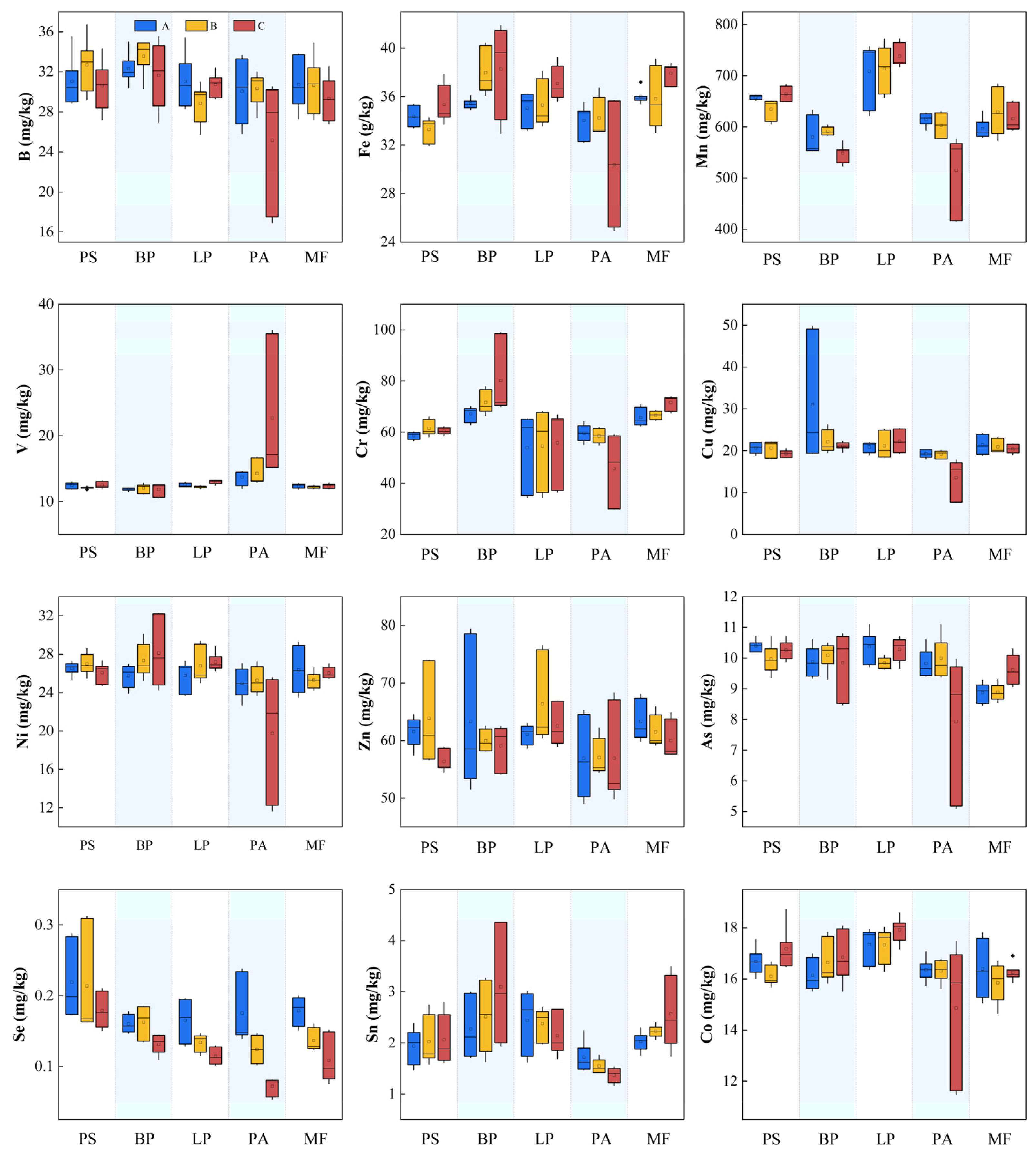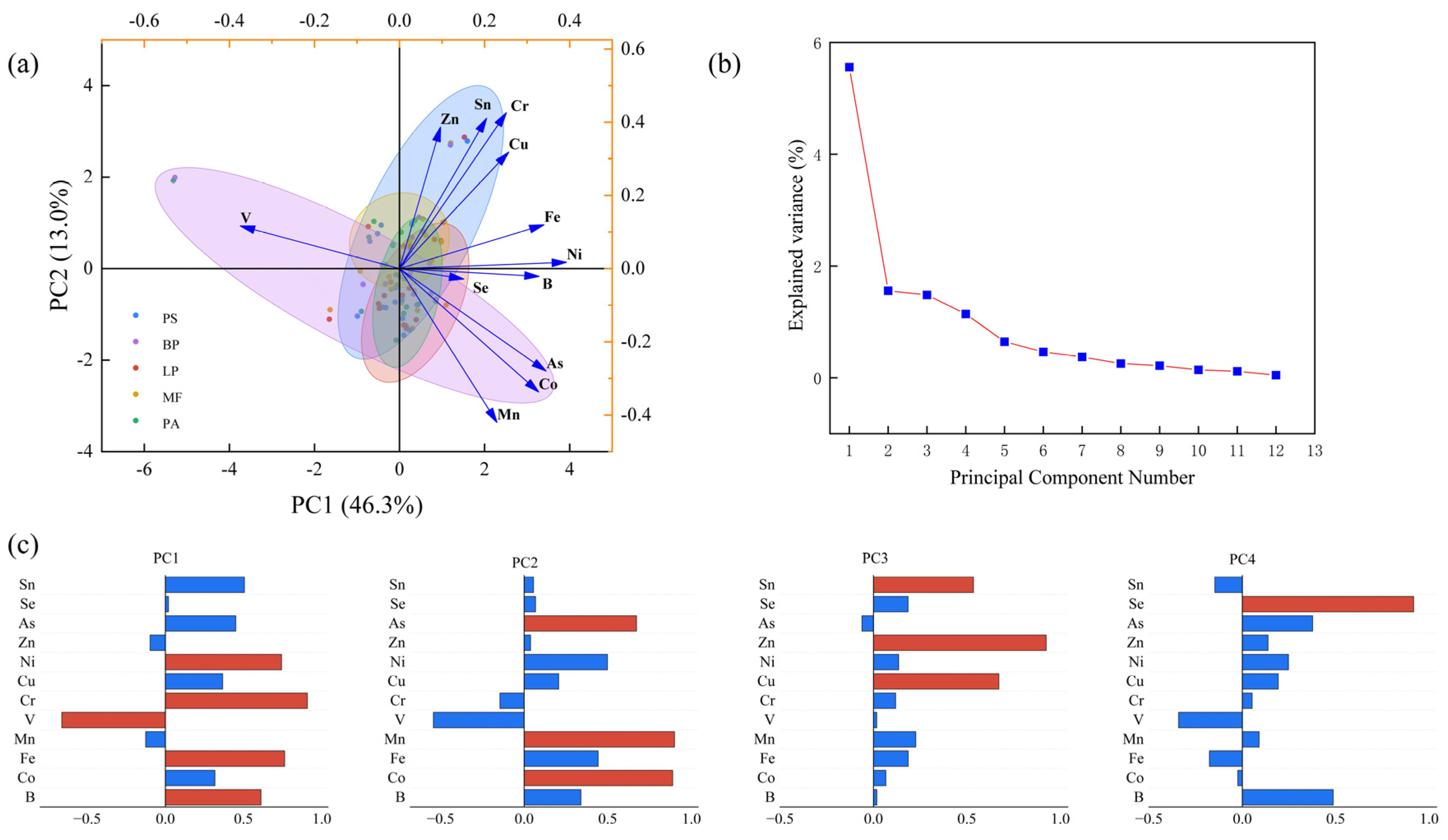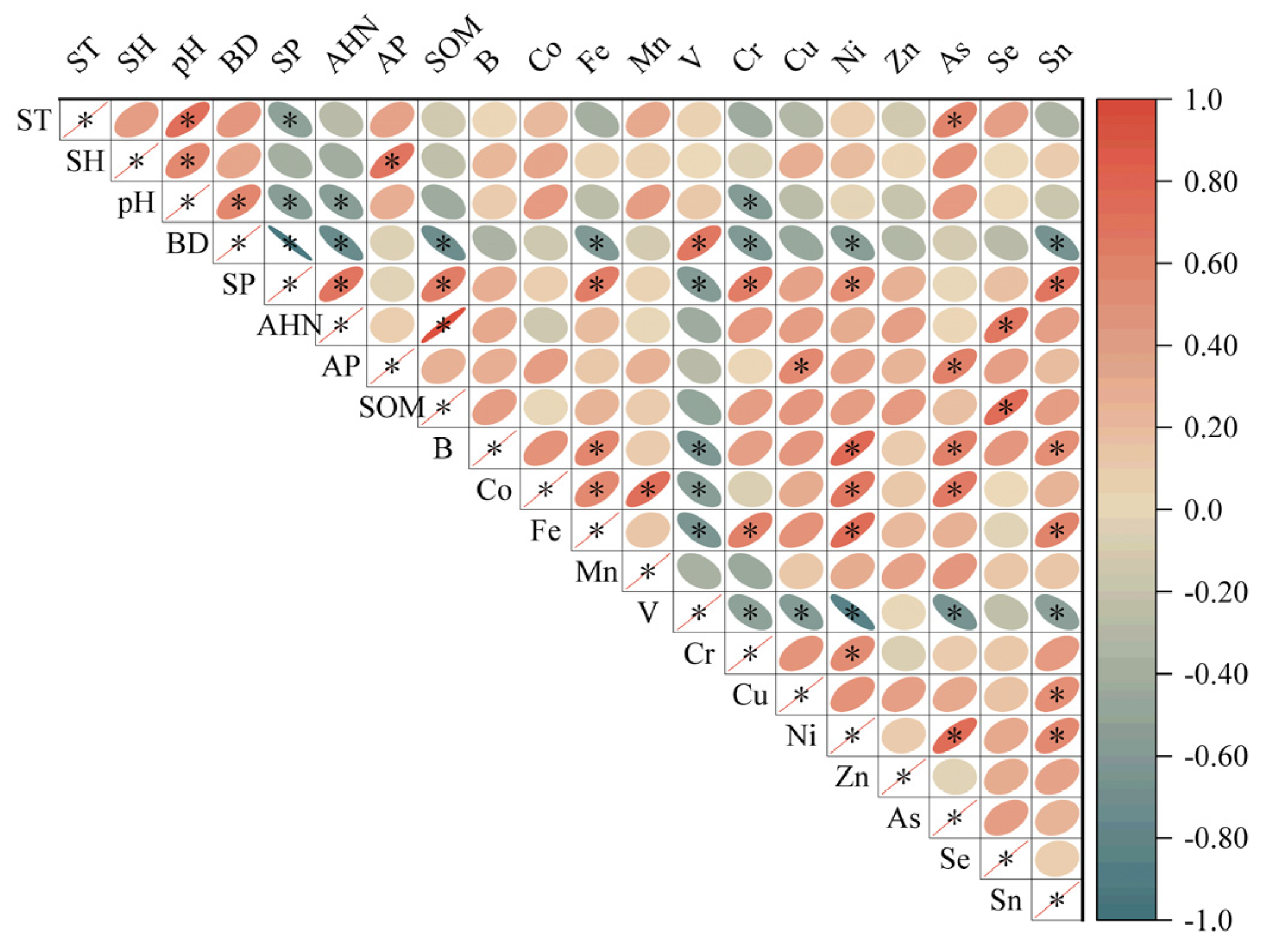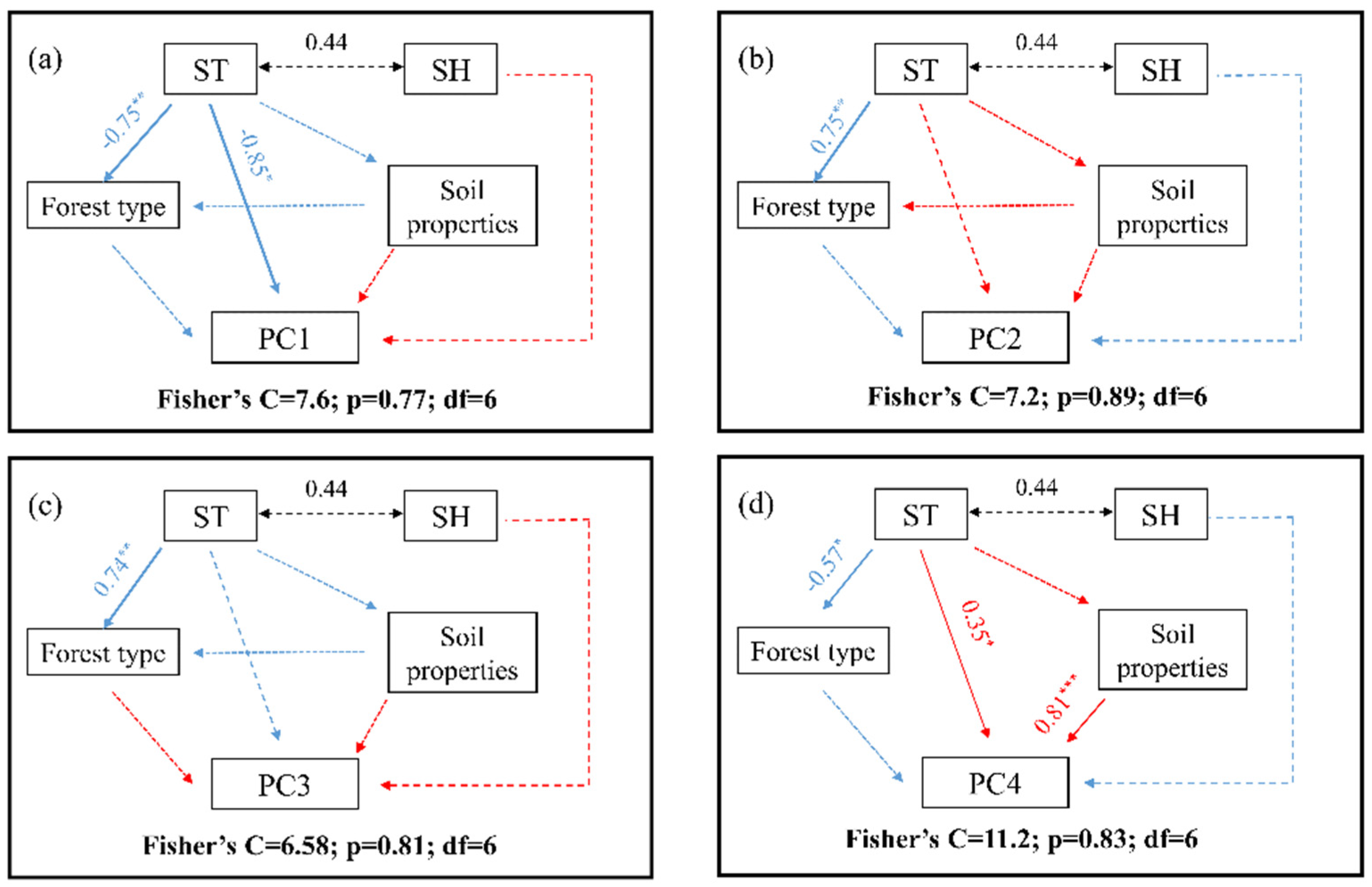Climate and Soil Properties Drive the Distribution of Minor and Trace Elements in Forest Soils of the Winter Olympic Core Area
Simple Summary
Abstract
1. Introduction
2. Materials and Methods
2.1. Study Area
2.2. Experimental Design
2.3. Soil Sample Collection and Chemical Analyses
2.4. Statistical Analysis
3. Results
3.1. Difference in Concentrations of Minor and Trace Elements in Five Forest Soils
3.2. Influences of Soil Depth and Forest Types on Minor and Trace Elements Concentrations
3.3. Relationships of Soil Minor and Trace Elements with Climate Soil Proportions
4. Discussion
4.1. Forest Type and Soil Depth Effect on Minor and Trace Elements in Soils
4.2. Soil Minor and Trace Elements in Relation to Soil Properties and Climate
5. Conclusions
Supplementary Materials
Author Contributions
Funding
Institutional Review Board Statement
Informed Consent Statement
Data Availability Statement
Acknowledgments
Conflicts of Interest
References
- Sexton, J.O.; Noojipady, P.; Song, X.-P.; Feng, M.; Song, D.-X.; Kim, D.-H.; Anand, A.; Huang, C.; Channan, S.; Pimm, S.L.; et al. Conservation policy and the measurement of forests. Nat. Clim. Change 2016, 6, 192–196. [Google Scholar] [CrossRef]
- Pan, Y.; Birdsey, R.A.; Fang, J.; Houghton, R.; Kauppi, P.E.; Kurz, W.A.; Phillips, O.L.; Shvidenko, A.; Lewis, S.L.; Canadell, J.G.; et al. A Large and Persistent Carbon Sink in the World’s Forests. Science 2011, 333, 988–993. [Google Scholar] [CrossRef] [PubMed]
- Wei, X.; Giles-Hansen, K.; Spencer, S.A.; Ge, X.; Onuchin, A.; Li, Q.; Burenina, T.; Ilintsev, A.; Hou, Y. Forest harvesting and hydrology in boreal Forests: Under an increased and cumulative disturbance context. For. Ecol. Manag. 2022, 522, 120468. [Google Scholar] [CrossRef]
- Burton, P.J.; Messier, C.; Adamowicz, W.L.; Kuuluvainen, T. Sustainable management of Canada’s boreal forests: Progress and prospects. Écoscience 2006, 13, 234–248. [Google Scholar] [CrossRef]
- Scheffer, M.; Hirota, M.; Holmgren, M.; Van Nes, E.H.; Chapin, F.S. Thresholds for boreal biome transitions. Proc. Natl. Acad. Sci. USA 2012, 109, 21384–21389. [Google Scholar] [CrossRef]
- Huang, C.; Liang, Y.; He, H.S.; Wu, M.M.; Liu, B.; Ma, T. Sensitivity of aboveground biomass and species composition to climate change in boreal forests of Northeastern China. Ecol. Model. 2021, 445, 109472. [Google Scholar] [CrossRef]
- Agnan, Y.; Courault, R.; Alexis, M.A.; Zanardo, T.; Cohen, M.; Sauvage, M.; Castrec-Rouelle, M. Distribution of trace and major elements in subarctic ecosystem soils: Sources and influence of vegetation. Sci. Total Environ. 2019, 682, 650–662. [Google Scholar] [CrossRef] [PubMed]
- Thornton, I.; Webb, J.S. Trace Elements in Soils and Plants. In Food Chains and Human Nutrition; Blaxter, K., Ed.; Springer: Dordrecht, The Netherlands, 1980; pp. 273–315. [Google Scholar] [CrossRef]
- Mehri, A. Trace Elements in Human Nutrition (II)—An Update. Int. J. Prev. Med. 2020, 11, 2. [Google Scholar] [CrossRef]
- Chen, Q.Y.; Costa, M. Arsenic: A Global Environmental Challenge. Annu. Rev. Pharmacol. Toxicol. 2021, 61, 47–63. [Google Scholar] [CrossRef]
- Trengove, C.L.; Judson, G.J. Trace element supplementation of sheep: Evaluation of various copper supplements and a soluble glass bullet containing copper, cobalt and selenium. Aust. Vet. J. 1985, 62, 321–324. [Google Scholar] [CrossRef] [PubMed]
- Gifford, S.; Dunstan, R.H.; O’Connor, W.; Roberts, T.; Toia, R. Pearl aquaculture—Profitable environmental remediation? Sci. Total Environ. 2004, 319, 27–37. [Google Scholar] [CrossRef] [PubMed]
- Sunda, W.G.; Huntsman, S.A. Processes regulating cellular metal accumulation and physiological effects: Phytoplankton as model systems. Sci. Total Environ. 1998, 219, 165–181. [Google Scholar] [CrossRef]
- Augusto, L.; Achat, D.L.; Jonard, M.; Vidal, D.; Ringeval, B. Soil parent material—A major driver of plant nutrient limitations in terrestrial ecosystems. Glob. Change Biol. 2017, 23, 3808–3824. [Google Scholar] [CrossRef]
- Sinsabaugh, R.L.; Lauber, C.L.; Weintraub, M.N.; Ahmed, B.; Allison, S.D.; Crenshaw, C.; Contosta, A.R.; Cusack, D.; Frey, S.; Gallo, M.E.; et al. Stoichiometry of soil enzyme activity at global scale. Ecol. Lett. 2008, 11, 1252–1264. [Google Scholar] [CrossRef]
- Vitousek, P.M.; Menge, D.N.; Reed, S.C.; Cleveland, C.C. Biological nitrogen fixation: Rates, patterns and ecological controls in terrestrial ecosystems. Philos. Trans. R. Soc. Lond. B Biol. Sci. 2013, 368, 20130119. [Google Scholar] [CrossRef]
- Delgado-Baquerizo, M.; Maestre, F.T.; Gallardo, A.; Bowker, M.A.; Wallenstein, M.D.; Quero, J.L.; Ochoa, V.; Gozalo, B.; García-Gómez, M.; Soliveres, S.; et al. Decoupling of soil nutrient cycles as a function of aridity in global drylands. Nature 2013, 502, 672–676. [Google Scholar] [CrossRef] [PubMed]
- Simpson, A.H.; Richardson, S.J.; Laughlin, D.C. Soil–climate interactions explain variation in foliar, stem, root and reproductive traits across temperate forests. Glob. Ecol. Biogeogr. 2016, 25, 964–978. [Google Scholar] [CrossRef]
- Tan, Q.; Wang, G. Decoupling of nutrient element cycles in soil and plants across an altitude gradient. Sci. Rep. 2016, 6, 34875. [Google Scholar] [CrossRef] [PubMed]
- Sun, D.-L.; Yao, B.-M.; Yang, G.; Sun, G.-X. Climate and soil properties regulate the vertical heterogeneity of minor and trace elements in the alpine topsoil of the Hengduan Mountains. Sci. Total Environ. 2023, 899, 165653. [Google Scholar] [CrossRef] [PubMed]
- Romero-Mujalli, G.; Hartmann, J.; Börker, J. Temperature and CO2 dependency of global carbonate weathering fluxes—Implications for future carbonate weathering research. Chem. Geol. 2019, 527, 118874. [Google Scholar] [CrossRef]
- Waring, B.G.; Weintraub, S.R.; Sinsabaugh, R.L. Ecoenzymatic stoichiometry of microbial nutrient acquisition in tropical soils. Biogeochemistry 2014, 117, 101–113. [Google Scholar] [CrossRef]
- Derakhshan-Babaei, F.; Mirchooli, F.; Mohammadi, M.; Nosrati, K.; Egli, M. Tracking the origin of trace metals in a watershed by identifying fingerprints of soils, landscape and river sediments. Sci. Total Environ. 2022, 835, 155583. [Google Scholar] [CrossRef]
- Ren, H.; Zhou, Q.; He, J.; Hou, Y.; Jiang, Y.; Rodrigues, J.L.M.; Cobb, A.B.; Wilson, G.W.T.; Hu, J.; Zhang, Y. Determining landscape-level drivers of variability for over fifty soil chemical elements. Sci. Total Environ. 2019, 657, 279–286. [Google Scholar] [CrossRef] [PubMed]
- Moreno-Jiménez, E.; Maestre, F.T.; Flagmeier, M.; Guirado, E.; Berdugo, M.; Bastida, F.; Dacal, M.; Díaz-Martínez, P.; Ochoa-Hueso, R.; Plaza, C.; et al. Soils in warmer and less developed countries have less micronutrients globally. Glob. Change Biol. 2023, 29, 522–532. [Google Scholar] [CrossRef]
- Huggett, A.J. The concept and utility of ‘ecological thresholds’ in biodiversity conservation. Biol. Conserv. 2005, 124, 301–310. [Google Scholar] [CrossRef]
- Li, W.; Xu, F.; Zheng, S.; Taube, F.; Bai, Y. Patterns and thresholds of grazing-induced changes in community structure and ecosystem functioning: Species-level responses and the critical role of species traits. J. Appl. Ecol. 2017, 54, 963–975. [Google Scholar] [CrossRef]
- Nelson, D.W.; Sommers, L.E. Total Carbon, Organic Carbon, and Organic Matter. In Methods of Soil Analysis. Part 2. Chem. Microbiological Properties; Wiley: Hoboken, NJ, USA, 1982; pp. 539–579. [Google Scholar] [CrossRef]
- Frank, K.; Beegle, D.; Denning, J. Phosphorus. In Recommended Chemical Soil Test Procedures; Brown, J.R., Ed.; North Central Regional Research Publication: Ames, IO, USA, 1998; Volume 221, pp. 21–30. [Google Scholar]
- Lefcheck, J.S. PiecewiseSEM: Piecewise structural equation modelling in r for ecology, evolution, and systematics. Methods Ecol. Evol. 2015, 7, 573–579. [Google Scholar] [CrossRef]
- Tian, P.; Liu, S.; Zhao, X.; Sun, Z.; Yao, X.; Niu, S.; Crowther, T.W.; Wang, Q. Past climate conditions predict the influence of nitrogen enrichment on the temperature sensitivity of soil respiration. Commun. Earth Environ. 2021, 2, 251. [Google Scholar] [CrossRef]
- Augusto, L.; De Schrijver, A.; Vesterdal, L.; Smolander, A.; Prescott, C.; Ranger, J. Influences of evergreen gymnosperm and deciduous angiosperm tree species on the functioning of temperate and boreal forests. Biol. Rev. 2014, 90, 444–466. [Google Scholar] [CrossRef] [PubMed]
- Garnier, E.; Laurent, G. Leaf anatomy, specific mass and water content in congeneric annual and perennial grass species. New Phytol. 1994, 128, 725–736. [Google Scholar] [CrossRef]
- Ding, J.; Kong, D.; Zhang, Z.; Cai, Q.; Xiao, J.; Liu, Q.; Yin, H. Climate and soil nutrients differentially drive multidimensional fine root traits in ectomycorrhizal-dominated alpine coniferous forests. J. Ecol. 2020, 108, 2544–2556. [Google Scholar] [CrossRef]
- Schroth, A.W.; Friedland, A.J.; Bostick, B.C. Macronutrient Depletion and Redistribution in Soils under Conifer and Northern Hardwood Forests. Soil Sci. Soc. Am. J. 2007, 71, 457–468. [Google Scholar] [CrossRef]
- Bing, H.; Wu, Y.; Zhou, J.; Li, R.; Luo, J.; Yu, D. Vegetation and Cold Trapping Modulating Elevation-dependent Distribution of Trace Metals in Soils of a High Mountain in Eastern Tibetan Plateau. Sci. Rep. 2016, 6, 24081. [Google Scholar] [CrossRef]
- Boyle, R.W. Elemental Associations in Mineral Deposits and Indicator Elements of Interest in Geochemical Prospecting (Revised); Queen’s Printer: Ottawa, ON, Canada, 1969. [Google Scholar]
- Négrel, P.; Ladenberger, A.; Demetriades, A.; Reimann, C.; Birke, M.; Sadeghi, M. GEMAS: Boron as a geochemical proxy for weathering of European agricultural soil. J. Geochem. Explor. 2024, 267, 107618. [Google Scholar] [CrossRef]
- Le Houérou, H.N. Biogeography of the arid steppeland north of the Sahara. J. Arid. Environ. 2001, 48, 103–128. [Google Scholar] [CrossRef]
- Slimani, H.; Aidoud, A.; Rozé, F. 30 Years of protection and monitoring of a steppic rangeland undergoing desertification. J. Arid. Environ. 2010, 74, 685–691. [Google Scholar] [CrossRef]
- Muñoz, M.Á.; Faz, Á. Soil and vegetation seasonal changes in the grazing Andean Mountain grasslands. J. Mt. Sci. 2014, 11, 1123–1137. [Google Scholar] [CrossRef]
- Zhang, Y.; Li, Y.; Shi, F.; Sun, X.; Lin, G. Seasonal and spatial variation in species diversity, abundance, and element accumulation capacities of macroalgae in mangrove forests of Zhanjiang, China. Acta Oceanol. Sin. 2014, 33, 73–82. [Google Scholar] [CrossRef]
- Ning, J.; Liu, S.; Kamran, M.; Sun, Y.; Xu, L.; Wang, H.; Zhang, M.; Chang, S.; West, C.P.; Hou, F. Trace elements apportionment in forage, soil, and livestock in rangeland ecosystems along climatic gradients. Environ. Res. 2022, 215, 114222. [Google Scholar] [CrossRef]
- Wu, X.; Fang, H.; Zhao, Y.; Smoak, J.M.; Li, W.; Shi, W.; Sheng, Y.; Zhao, L.; Ding, Y. A conceptual model of the controlling factors of soil organic carbon and nitrogen densities in a permafrost-affected region on the eastern Qinghai-Tibetan Plateau. J. Geophys. Res. Biogeosci. 2017, 122, 1705–1717. [Google Scholar] [CrossRef]
- Wu, X.; Zhao, L.; Fang, H.; Zhao, Y.; Smoak, J.M.; Pang, Q.; Ding, Y. Environmental controls on soil organic carbon and nitrogen stocks in the high-altitude arid western Qinghai-Tibetan Plateau permafrost region. J. Geophys. Res. Biogeosci. 2016, 121, 176–187. [Google Scholar] [CrossRef]
- Jones, G.D.; Droz, B.; Greve, P.; Gottschalk, P.; Poffet, D.; McGrath, S.P.; Seneviratne, S.I.; Smith, P.; Winkel, L.H.E. Selenium deficiency risk predicted to increase under future climate change. Proc. Natl. Acad. Sci. USA 2017, 114, 2848–2853. [Google Scholar] [CrossRef]
- Tolu, J.; Bouchet, S.; Helfenstein, J.; Hausheer, O.; Chékifi, S.; Frossard, E.; Tamburini, F.; Chadwick, O.A.; Winkel, L.H.E. Understanding soil selenium accumulation and bioavailability through size resolved and elemental characterization of soil extracts. Nat. Commun. 2022, 13, 6974. [Google Scholar] [CrossRef]
- Meharg, A.A.; Meharg, C. The Pedosphere as a Sink, Source, and Record of Anthropogenic and Natural Arsenic Atmospheric Deposition. Environ. Sci. Technol. 2021, 55, 7757–7769. [Google Scholar] [CrossRef]
- Bradl, H.B. Adsorption of heavy metal ions on soils and soils constituents. J. Colloid. Interface Sci. 2004, 277, 1–18. [Google Scholar] [CrossRef] [PubMed]
- Khan, Z.I.; Ashraf, M.; Hussain, A.; McDowell, L.R. Seasonal Variation of Trace Elements in a Semiarid Veld Pasture. Commun. Soil. Sci. Plant Anal. 2006, 37, 1471–1483. [Google Scholar] [CrossRef]
- Liu, W.; Wu, Y.; Zhong, Y.; Zhao, H. Concentrations, distribution and influencing factors of selenium (Se) in soil of arid and semi-arid climate: A case from Zhangye-Yongchang region, north-western China. J. Geochem. Explor. 2023, 250, 107239. [Google Scholar] [CrossRef]
- Dinh, Q.T.; Cui, Z.; Huang, J.; Tran, T.A.T.; Wang, D.; Yang, W.; Zhou, F.; Wang, M.; Yu, D.; Liang, D. Selenium distribution in the Chinese environment and its relationship with human health: A review. Environ. Int. 2018, 112, 294–309. [Google Scholar] [CrossRef] [PubMed]
- Mehdi, Y.; Hornick, J.L.; Istasse, L.; Dufrasne, I. Selenium in the environment, metabolism and involvement in body functions. Molecules 2013, 18, 3292–3311. [Google Scholar] [CrossRef]
- Jie, L.; Zhiqiang, Y.; Zhigang, L.; Guodong, Z.; Yinghui, W.; Biao, C. Distribution of selenium in soils of Nanning city and its influencing factors. Acta Pedol. 2012, 49, 1012–1020. [Google Scholar] [CrossRef]





Disclaimer/Publisher’s Note: The statements, opinions and data contained in all publications are solely those of the individual author(s) and contributor(s) and not of MDPI and/or the editor(s). MDPI and/or the editor(s) disclaim responsibility for any injury to people or property resulting from any ideas, methods, instructions or products referred to in the content. |
© 2025 by the authors. Licensee MDPI, Basel, Switzerland. This article is an open access article distributed under the terms and conditions of the Creative Commons Attribution (CC BY) license (https://creativecommons.org/licenses/by/4.0/).
Share and Cite
Wu, X.; Zhang, H.; Wang, Z.; Tian, W.; Liu, Z. Climate and Soil Properties Drive the Distribution of Minor and Trace Elements in Forest Soils of the Winter Olympic Core Area. Biology 2025, 14, 82. https://doi.org/10.3390/biology14010082
Wu X, Zhang H, Wang Z, Tian W, Liu Z. Climate and Soil Properties Drive the Distribution of Minor and Trace Elements in Forest Soils of the Winter Olympic Core Area. Biology. 2025; 14(1):82. https://doi.org/10.3390/biology14010082
Chicago/Turabian StyleWu, Xiaochang, Huayong Zhang, Zhongyu Wang, Wang Tian, and Zhao Liu. 2025. "Climate and Soil Properties Drive the Distribution of Minor and Trace Elements in Forest Soils of the Winter Olympic Core Area" Biology 14, no. 1: 82. https://doi.org/10.3390/biology14010082
APA StyleWu, X., Zhang, H., Wang, Z., Tian, W., & Liu, Z. (2025). Climate and Soil Properties Drive the Distribution of Minor and Trace Elements in Forest Soils of the Winter Olympic Core Area. Biology, 14(1), 82. https://doi.org/10.3390/biology14010082







